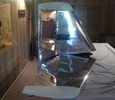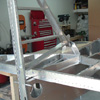


random user submitted photo
compression ratio
10 posts
• Page 1 of 1
compression ratio
I'm getting apparently excessive valve wear at about 100 hours. When I set up the 8:1 compression ratio, it required only minimal shim height. When doing compression tests with an automotive tester (cranking the engine) I get 155 psi. This is more than 10 times atmospheric pressure. Does this mean my compression ratio is too high? Sonex only tests their engines with a leakdown tester.
Bill
Bill
Bill, Oregon
2012 Sonex taildragger (kit)
Aerovee 2.1, Aeroinjector
2012 Sonex taildragger (kit)
Aerovee 2.1, Aeroinjector
- billmaxmcw
- Posts: 44
- Joined: Mon Apr 14, 2014 6:06 pm
Re: compression ratio
Compression Ratio and PSI are not directly related to each other. The compression ratio is how much (in volume) the piston compresses the air from the bottom of the stroke to the top. PSI is how high the pressure gets during that stroke. PSI is related to things such as cam timing, valve leak, piston ring seal, etc and can vary quite a bit. Compression ratio is a fixed number that is set depending on the stroke length and size of the piston. It does not matter what your compression ratio is when looking at PSI. Think of it this way, if you had a bad valve that leaked you could have zero PSI while still having 8:1 compression ratio. That being said, 155 sounds about normal for a VW. If it drops below 100 that is when I would start to worry.
Keith
#554
Keith
#554
- kmacht
- Posts: 772
- Joined: Tue Jun 21, 2011 11:30 am
Re: compression ratio
billmaxmcw wrote:I'm getting apparently excessive valve wear at about 100 hours.
Bill -
When you say "Valve Wear", what do you mean? Are your exhaust valves showing signs of over-temp? Is there a visible problem with the valve seat or valve guide? Some more details may help folks track down the problem.
--Noel
P.S. On the EAA website, Mike Busch has some great webinars on engine components and wear - including valves. Might be worth checking out.
- NWade
- Posts: 527
- Joined: Mon Aug 08, 2011 3:58 pm
Re: compression ratio
I think I've been running too lean, which could lead to the exhaust valve leaks, but that's a different topic. Looks like too high compression would not contribute.
Bill
Bill
Bill, Oregon
2012 Sonex taildragger (kit)
Aerovee 2.1, Aeroinjector
2012 Sonex taildragger (kit)
Aerovee 2.1, Aeroinjector
- billmaxmcw
- Posts: 44
- Joined: Mon Apr 14, 2014 6:06 pm
Re: compression ratio
It would seem that higher compression ratios would lead to higher operating temps and more stress on the bearings, etc. If you were willing to give up a bit of horsepower, you would get a more reliable and longer-lasting engine at 7:1 compression ratio.
Bill
Bill
Bill, Oregon
2012 Sonex taildragger (kit)
Aerovee 2.1, Aeroinjector
2012 Sonex taildragger (kit)
Aerovee 2.1, Aeroinjector
- billmaxmcw
- Posts: 44
- Joined: Mon Apr 14, 2014 6:06 pm
Re: compression ratio
billmaxmcw wrote:It would seem that higher compression ratios would lead to higher operating temps and more stress on the bearings, etc. If you were willing to give up a bit of horsepower, you would get a more reliable and longer-lasting engine at 7:1 compression ratio.
Bill
Does anyone know the difference in HP between the low compression ratio set up and high compression ratio?
Darick Gundy
Sonex #1646
N417DG
Taildragger, Aerovee, center stick, Prince P-Tip Prop
MGL E1, F2, V6 radio, Sandia Xponder, Reserve lift indicator (AOA), iFly 520
First flight! 10/21/2017
Sonex #1646
N417DG
Taildragger, Aerovee, center stick, Prince P-Tip Prop
MGL E1, F2, V6 radio, Sandia Xponder, Reserve lift indicator (AOA), iFly 520
First flight! 10/21/2017
-

Darick - Posts: 496
- Joined: Mon Aug 05, 2013 9:39 pm
- Location: PA
Re: compression ratio
According to Mark Schiable at Sonex it is 80 HP versus about 75 HP for the 7:1 compression. Jake
-

SonexN76ET - Posts: 494
- Joined: Tue Aug 27, 2013 2:39 pm
- Location: Atlanta
Re: compression ratio
Atmospheric pressure is 14.7 psi. If you measure 155 psi, then the compression ratio is at least 155/14.7 = 10.5
P*V = constant
P1*V1 = P2*V2
P1/P2 = V2/V1
By definition the CR is defined as CR = (Pi/4 * bore² *stroke + V_head)/V_head = V2/V1 = P1/P2
When you measure 155 psi, either the pressure meter is way off or you have done something very wrong when setting it up.
P*V = constant
P1*V1 = P2*V2
P1/P2 = V2/V1
By definition the CR is defined as CR = (Pi/4 * bore² *stroke + V_head)/V_head = V2/V1 = P1/P2
When you measure 155 psi, either the pressure meter is way off or you have done something very wrong when setting it up.
Reserved LN-ENX for Onex #134
Onex build log
Onex build log
- SvingenB
- Posts: 125
- Joined: Tue Oct 08, 2013 5:38 pm
Re: compression ratio
SvingenB wrote:When you measure 155 psi, either the pressure meter is way off or you have done something very wrong when setting it up.
The equation you are using assumes the temperature of the air in the cylinder is constant.
This is not true--the work you exert in compressing the air heats it up and increases the pressure more than a simple ratio of volumes would imply. The equation will only work if you compressed the cylinder and left it long enough for it to return to the original temperature. In reality, our imperfectly-sealed cylinders will completely leak long before the temperature returns to steady state.
A better approximation requires the use of "gamma", the heat capacity ratio of the gas which is about 1.4 for air.
P1*V1^gamma = P2*V2^gamma
P1*V1^gamma = P2*(CR*V1)^gamma
P1 = P2 * CR^gamma
CR = (P1/P2)^(1/gamma)
CR = ((155+14.7)/14.7)^(1/1.4)
CR = 5.7
So, instead of it seeming like his compression ratio is way too high, it seems too low. We expect it to be lower than the actual number and there isn't really an easy way to know how much lower it should be. Any air that leaked from the cylinder before the valves were totally closed, during compression, or heat that was lost to the cylinder walls would reduce the pressure that was measured and explain this result. No red flags here. Keith explained this pretty well.
You can't really use this technique to determine compression ratio except maybe if someone with the exact same engine and a known compression ratio tested the same way and shared their results.
- gammaxy
- Posts: 600
- Joined: Wed Sep 04, 2013 9:31 am
Re: compression ratio
Didn't think gamma was that important here, but obviously it is.
Reserved LN-ENX for Onex #134
Onex build log
Onex build log
- SvingenB
- Posts: 125
- Joined: Tue Oct 08, 2013 5:38 pm
10 posts
• Page 1 of 1
Who is online
Users browsing this forum: No registered users and 62 guests







